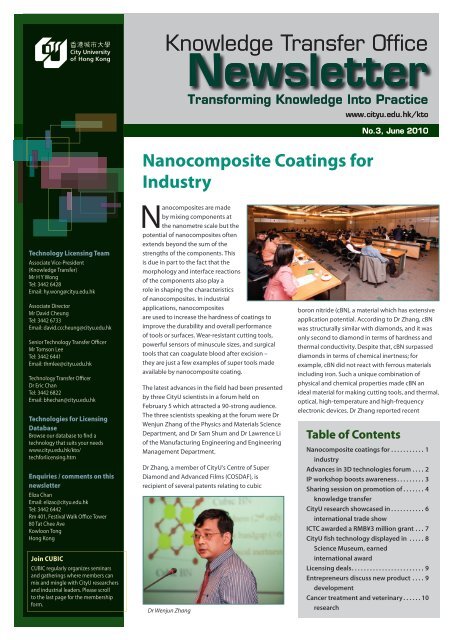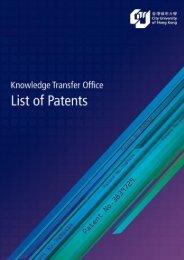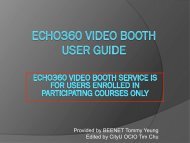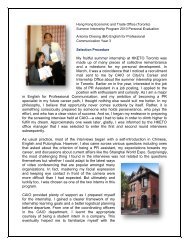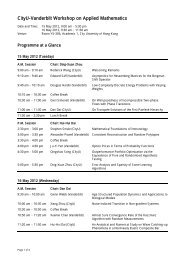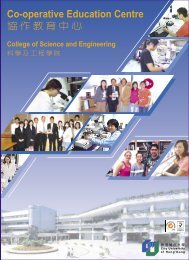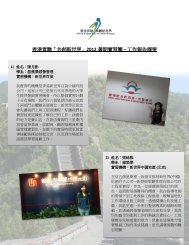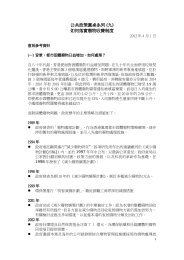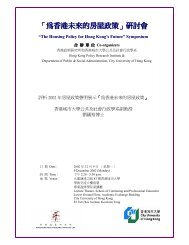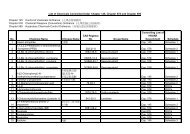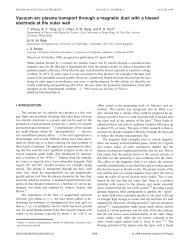Newsletter 1 - City University of Hong Kong
Newsletter 1 - City University of Hong Kong
Newsletter 1 - City University of Hong Kong
You also want an ePaper? Increase the reach of your titles
YUMPU automatically turns print PDFs into web optimized ePapers that Google loves.
Technology Licensing Team<br />
Associate Vice-President<br />
(Knowledge Transfer)<br />
Mr H Y Wong<br />
Tel: 3442 6428<br />
Email: hy.wong@cityu.edu.hk<br />
Associate Director<br />
Mr David Cheung<br />
Tel: 3442 6733<br />
Email: david.cccheung@cityu.edu.hk<br />
Senior Technology Transfer Officer<br />
Mr Tomson Lee<br />
Tel: 3442 6441<br />
Email: thmlee@cityu.edu.hk<br />
Technology Transfer Officer<br />
Dr Eric Chan<br />
Tel: 3442 6822<br />
Email: bhechan@cityu.edu.hk<br />
Technologies for Licensing<br />
Database<br />
Browse our database to find a<br />
technology that suits your needs<br />
www.cityu.edu.hk/kto/<br />
techforlicensing.htm<br />
Enquiries / comments on this<br />
newsletter<br />
Eliza Chan<br />
Email: elizac@cityu.edu.hk<br />
Tel: 3442 6442<br />
Rm 401, Festival Walk Office Tower<br />
80 Tat Chee Ave<br />
Kowloon Tong<br />
<strong>Hong</strong> <strong>Kong</strong><br />
Join CUBIC<br />
CUBIC regularly organizes seminars<br />
and gatherings where members can<br />
mix and mingle with <strong>City</strong>U researchers<br />
and industrial leaders. Please scroll<br />
to the last page for the membership<br />
form.<br />
Knowledge Transfer Office<br />
<strong>Newsletter</strong><br />
Transforming Knowledge Into Practice<br />
Nanocomposite Coatings for<br />
Industry<br />
Nanocomposites are made<br />
by mixing components at<br />
the nanometre scale but the<br />
potential <strong>of</strong> nanocomposites <strong>of</strong>ten<br />
extends beyond the sum <strong>of</strong> the<br />
strengths <strong>of</strong> the components. This<br />
is due in part to the fact that the<br />
morphology and interface reactions<br />
<strong>of</strong> the components also play a<br />
role in shaping the characteristics<br />
<strong>of</strong> nanocomposites. In industrial<br />
applications, nanocomposites<br />
are used to increase the hardness <strong>of</strong> coatings to<br />
improve the durability and overall performance<br />
<strong>of</strong> tools or surfaces. Wear-resistant cutting tools,<br />
powerful sensors <strong>of</strong> minuscule sizes, and surgical<br />
tools that can coagulate blood after excision –<br />
they are just a few examples <strong>of</strong> super tools made<br />
available by nanocomposite coating.<br />
The latest advances in the field had been presented<br />
by three <strong>City</strong>U scientists in a forum held on<br />
February 5 which attracted a 90-strong audience.<br />
The three scientists speaking at the forum were Dr<br />
Wenjun Zhang <strong>of</strong> the Physics and Materials Science<br />
Department, and Dr Sam Shum and Dr Lawrence Li<br />
<strong>of</strong> the Manufacturing Engineering and Engineering<br />
Management Department.<br />
Dr Zhang, a member <strong>of</strong> <strong>City</strong>U’s Centre <strong>of</strong> Super<br />
Diamond and Advanced Films (COSDAF), is<br />
recipient <strong>of</strong> several patents relating to cubic<br />
Dr Wenjun Zhang<br />
www.cityu.edu.hk/kto<br />
No.3, June 2010<br />
boron nitride (cBN), a material which has extensive<br />
application potential. According to Dr Zhang, cBN<br />
was structurally similar with diamonds, and it was<br />
only second to diamond in terms <strong>of</strong> hardness and<br />
thermal conductivity. Despite that, cBN surpassed<br />
diamonds in terms <strong>of</strong> chemical inertness; for<br />
example, cBN did not react with ferrous materials<br />
including iron. Such a unique combination <strong>of</strong><br />
physical and chemical properties made cBN an<br />
ideal material for making cutting tools, and thermal,<br />
optical, high-temperature and high-frequency<br />
electronic devices. Dr Zhang reported recent<br />
Table <strong>of</strong> Contents<br />
Nanocomposite coatings for . . . . . . . . . . . 1<br />
industry<br />
Advances in 3D technologies forum . . . . 2<br />
IP workshop boosts awareness . . . . . . . . . 3<br />
Sharing session on promotion <strong>of</strong> . . . . . . . 4<br />
knowledge transfer<br />
<strong>City</strong>U research showcased in . . . . . . . . . . . 6<br />
international trade show<br />
ICTC awarded a RMB¥3 million grant . . . 7<br />
<strong>City</strong>U fish technology displayed in . . . . . 8<br />
Science Museum, earned<br />
international award<br />
Licensing deals . . . . . . . . . . . . . . . . . . . . . . . . 9<br />
Entrepreneurs discuss new product . . . . 9<br />
development<br />
Cancer treatment and veterinary . . . . . . 10<br />
research
2<br />
advances in synthesizing high-quality,<br />
thick, non-delaminating cBN films by<br />
a new method developed by his team,<br />
and demonstrated several examples <strong>of</strong><br />
cBN-based nanocomposite structures in<br />
mechanical and electronic applications.<br />
The technology is patented in the US.<br />
Both Dr Shum and Dr Li are members<br />
<strong>of</strong> the Advanced Coatings Applied<br />
Research Laboratory (ACARL), a facility<br />
set up with government funding and<br />
industrial sponsorship. As research<br />
fellow <strong>of</strong> the Centre, Dr Shum was<br />
responsible for the development <strong>of</strong><br />
a multi-functional physical vapour<br />
deposition (PVD) system for producing<br />
nanocomposite superhard coatings.<br />
While a similar PVD system made in the<br />
US or Europe could fetch HK$4 million or<br />
more, the production cost <strong>of</strong> the ACARL<br />
system could be half that price or even<br />
lower. Another advantage <strong>of</strong> the system<br />
was that the hardness <strong>of</strong> coatings could<br />
be significantly increased from 20 to 50<br />
GPa or higher. On top <strong>of</strong> provision <strong>of</strong><br />
hardware, Dr Shum and his team also<br />
planned to provide aftersales services<br />
and technical support to users based<br />
in <strong>Hong</strong> <strong>Kong</strong> and the Pearl River Delta<br />
region.<br />
Hydrophobic (or water-repellent)<br />
Dr Sam Shum<br />
Pr<strong>of</strong> Horace Ip<br />
Knowledge Transfer Office <strong>Newsletter</strong> – No.3 June 2010<br />
treatment <strong>of</strong> surgical tools is<br />
a good example <strong>of</strong> applying<br />
surface engineering technology<br />
for biomedical manufacturing.<br />
Dr Lawrence Li has succeeded<br />
in developing improved<br />
surface treatment methods<br />
tailored for advanced radio-frequency<br />
(RF) electrosurgical tools, such as RF<br />
scissors, forceps and scalpels, that<br />
could coagulate blood to minimize<br />
Dr Lawrence Li<br />
Advances in 3D Technologies Forum<br />
In another Technology Transfer<br />
Forum held on 14 May, Pr<strong>of</strong> Horace<br />
Ip and Dr Peter Tsang shared their<br />
experience in applying and developing<br />
3D technologies. About 130 business<br />
executives, industrial leaders, and <strong>City</strong>U<br />
staff and students attended the event.<br />
Creativity and sensory experience<br />
through 3D technology<br />
Pr<strong>of</strong> Horace Ip, Acting Vice-President<br />
(Research and Technology) and Director<br />
<strong>of</strong> the AIMtech Center, is an expert on<br />
multimedia and pattern recognition. He<br />
gave an interesting account <strong>of</strong> how, with<br />
the help <strong>of</strong> multimedia technologies,<br />
users can interact with 3D content to<br />
create novel sensory experience.<br />
Given the advent <strong>of</strong> 3D technology<br />
and the availability <strong>of</strong> high-quality<br />
3D content, the focus <strong>of</strong> future<br />
development <strong>of</strong> 3D technology, as<br />
well as its business potential, lies in the<br />
provision <strong>of</strong> novel user multi-modal<br />
experience through interacting with<br />
3D content. A good example is Pr<strong>of</strong> Ip’s<br />
Smart Ambience Therapy (SAT) system<br />
for use in art therapy and psychotherapy.<br />
By using 3D body gesture recognition<br />
and real-time graphics technologies,<br />
SAT creates an environment <strong>of</strong> virtual<br />
reality with which users can interact. The<br />
system was designed in collaboration<br />
with the <strong>Hong</strong> <strong>Kong</strong> Association <strong>of</strong><br />
Art Therapies with an aim to help<br />
emotionally and physically abused<br />
children articulate themselves. Social<br />
damage to patients. The electrode at<br />
the tip <strong>of</strong> the tool was usually coated<br />
with Teflon to avoid picking up human<br />
tissues during operation. However,<br />
possible carcinogens in Teflon had<br />
raised concerns over its suitability as a<br />
coating material used in surgical tools at<br />
elevated temperatures. Dr Li’s method<br />
<strong>of</strong>fered a useful alternative to Teflon<br />
coating by implementing micro patterns<br />
on surfaces through laser ablation. It<br />
served to reduce the adhesion between<br />
the surgical tool and human tissue,<br />
and a thin film <strong>of</strong> carbon coating was<br />
applied on top to enhance the non-stick<br />
performance.<br />
services organizations such as<br />
Against Child Abuse and Caritas<br />
have adopted SAT, which is now a<br />
semi-permanent exhibition at the<br />
<strong>Hong</strong> <strong>Kong</strong> Science Museum.<br />
An earlier 3D interactive media<br />
system called Body Brush,<br />
also pioneered by Pr<strong>of</strong> Ip in<br />
collaboration with local artists and<br />
contemporary dancers, captures<br />
3D body motion and transforms it into<br />
3D paintings projected by a stereo<br />
projector. Body Brush even attracted<br />
the attention <strong>of</strong> the world-renowned<br />
artist Wu Guanzhong, who once used<br />
the system to create “motion paintings”.<br />
Video recording <strong>of</strong> Mr Wu creating<br />
3D paintings with Body Brush was<br />
broadcast in a recent exhibition <strong>of</strong><br />
Mr Wu’s paintings in the <strong>Hong</strong> <strong>Kong</strong><br />
Museum <strong>of</strong> Art.<br />
Pr<strong>of</strong> Ip’s 3D technology, developed with<br />
the help <strong>of</strong> his students, does more than
3<br />
just rendering body motion into visual<br />
representations. It also translates body<br />
motion into music, as manifested by<br />
CyberComposer and Body Baton, which<br />
was covered in a CNN documentary<br />
broadcast worldwide.<br />
<strong>City</strong>U’s pioneering work on the<br />
exploitation <strong>of</strong> 3D technology, according<br />
to Pr<strong>of</strong> Ip, provide a glimpse <strong>of</strong> the<br />
vast potential <strong>of</strong> 3D technology in<br />
transforming and extending the realm<br />
<strong>of</strong> users experience in diverse areas that<br />
range from health-care to edutainment.<br />
Lens-free 3D display<br />
In the presentation and real-time<br />
demonstration sessions to follow, Dr<br />
Peter Tsang <strong>of</strong> the Electronic Engineering<br />
Department enlightened the audience<br />
with his leading edge research on<br />
3D technologies, in particular the<br />
production, display and distribution <strong>of</strong><br />
3D video and TV content.<br />
The multimedia industry and the general<br />
public at large are keen to explore<br />
Dr Peter Tsang<br />
Knowledge Transfer Office <strong>Newsletter</strong> – No.3 June 2010<br />
effective approaches to view 3D content<br />
without using coloured or polarized<br />
glasses. One available technique is to<br />
adopt the static N-tile methodology.<br />
Multiple views <strong>of</strong> the same object are<br />
fed into a multiplexer which in turn<br />
generates a 2D image for broadcast via<br />
existing TV channels and for storage<br />
in current video standards. Despite its<br />
convenience in display and storage, the<br />
aforementioned technology may lead to<br />
degradation <strong>of</strong> image quality.<br />
To address the shortfall <strong>of</strong> the N-tile<br />
IP Workshop Boosts Awareness<br />
To capture and realize<br />
the commercial<br />
value <strong>of</strong> knowledge,<br />
universities and inventors need<br />
to manage and protect their<br />
intellectual properties (IPs).<br />
Without proper IP protection,<br />
opportunists are given free rein<br />
to appropriate novel designs,<br />
works <strong>of</strong> art, and inventions,<br />
reaping the benefits <strong>of</strong> IPs due<br />
to the rightful creator. To raise<br />
awareness in IP management,<br />
the KTO organized a three-day<br />
workshop at the <strong>Hong</strong> <strong>Kong</strong><br />
Productivity Council, which was<br />
attended by 30 <strong>City</strong>U staff members<br />
and students.<br />
The IP course, first <strong>of</strong> its kind in <strong>City</strong>U,<br />
is part <strong>of</strong> the KTO’s strategic plan to<br />
strengthen knowledge transfer and<br />
technology licensing. “Effective IP<br />
protection helps us make the most <strong>of</strong><br />
our intellectual resources and empower<br />
<strong>City</strong>U’s knowledge transfer (KT)<br />
endeavours,” remarked Mr H Y Wong,<br />
Associate Vice-President <strong>of</strong> KT.<br />
Dr Keeson Shum<br />
The workshop gave a brief walkthrough<br />
<strong>of</strong> the various means <strong>of</strong> IP protection,<br />
but more weight was given to patenting.<br />
On top <strong>of</strong> protection, patents also <strong>of</strong>fer<br />
valuable business intelligence essential<br />
to applied research and product design.<br />
For example, to maximize the chance <strong>of</strong><br />
success in new product development,<br />
one should “design around” the<br />
patented technologies or designs owned<br />
by competitors. To avoid infringing on<br />
valid patents, one would have to draw<br />
format, Dr Tsang has developed<br />
the dynamic-tile format, which is<br />
capable <strong>of</strong> yielding images with<br />
higher resolution. This invention<br />
can be implemented by both<br />
s<strong>of</strong>tware and hardware means.<br />
Most important <strong>of</strong> all, this unique<br />
technology is compatible with<br />
existing video chains, meaning<br />
that the storage, distribution,<br />
and display <strong>of</strong> 3D content do not<br />
require overhauls <strong>of</strong> the existing video<br />
infrastructure.<br />
Concerning the future development<br />
<strong>of</strong> 3D display technology, Dr Tsang<br />
has embarked on the research <strong>of</strong><br />
computer generated holography.<br />
Digital holograms derived from 3D<br />
computer graphic models can be used<br />
to reconstruct 3D images, but it involves<br />
heavy computation in the process. Dr<br />
Tsang has developed a fast method <strong>of</strong><br />
generating holograms and his findings<br />
have been recently published in<br />
international journals.<br />
on patent search and analysis,<br />
as well as the basic skills <strong>of</strong><br />
interpreting and writing a<br />
patent.<br />
Feedback from participants<br />
was overwhelming, reflecting<br />
the demand for more<br />
education programmes in IP<br />
management. Dr Keeson Shum,<br />
Senior Engineer <strong>of</strong> the State<br />
Key Lab <strong>of</strong> Millimeter Waves,<br />
admitted that the workshop<br />
inspired him to see his research<br />
in a new light.<br />
“ I realize now that as an engineer<br />
working with industrial partners, I need<br />
to pay more heed to IP.<br />
“I had reservation about the usefulness<br />
<strong>of</strong> IP, thinking that it wasn’t necessary<br />
to seek IP protection unless you were<br />
certain <strong>of</strong> the commercial value <strong>of</strong> your<br />
research work. But in most cases if you<br />
only seek protection then it is usually<br />
too late. Now I am beginning to see my<br />
research in a different light — that it is<br />
indeed worth patenting.”
4<br />
Dr Shum found patent analysis especially<br />
useful to formulating research design<br />
and business strategies. Patent analysis<br />
can yield important information about<br />
specific categories <strong>of</strong> patents. For<br />
instance, you can find out how many<br />
patents in OLED have been filed over<br />
time, the pr<strong>of</strong>ile <strong>of</strong> their owners, and<br />
the expiry dates <strong>of</strong> patents. With a<br />
good grasp <strong>of</strong> patenting trends, both<br />
researchers and their industrial partners<br />
can benefit from better planning.<br />
Dr Zhou Zhifeng, Senior Research<br />
Fellow <strong>of</strong> ACARL, also shared Dr Shum’s<br />
appreciation for patent search and<br />
analysis. Specializing in advanced<br />
coating, Dr Zhou was aware <strong>of</strong> the<br />
intense competition in his field in the<br />
Pearl River Delta region. Patent analysis<br />
would help him keep abreast with the<br />
latest advances in coating.<br />
Knowledge Transfer Office <strong>Newsletter</strong> – No.3 June 2010<br />
Pre-mature disclosure was another<br />
issue that concerned Dr Zhou. In<br />
most countries, inventions previously<br />
disclosed in public or in publications<br />
are not patentable because only novel<br />
inventions are to be patented. Although<br />
some countries such as the US allow<br />
research results published within 12<br />
months to be filed for patents, it makes<br />
good sense to file applications as early<br />
as possible.<br />
“Observing discretion is crucial to<br />
patent application, in spite <strong>of</strong> the fact<br />
that inventors are always expected to<br />
publicise their research achievements,”<br />
Dr Zhou said.<br />
The restriction on disclosure is <strong>of</strong>ten<br />
regarded as a discouragement to<br />
academics who need to “get published”.<br />
Dr Chan Cheung Fat <strong>of</strong> the Electronic<br />
Engineering Department did not agree,<br />
however.<br />
Sharing Session on Promotion <strong>of</strong><br />
Knowledge Transfer<br />
On top <strong>of</strong> classroom teaching<br />
and basic research, universities<br />
are also expected to transfer or<br />
commercialize the results <strong>of</strong> publiclyfunded<br />
research for the benefit <strong>of</strong> the<br />
community. In a seminar organized<br />
by <strong>City</strong>U on February 26, leaders <strong>of</strong><br />
distinguished universities and research<br />
institutes were invited to share views<br />
on the obstacles <strong>of</strong> implementing<br />
knowledge transfer and their possible<br />
solutions.<br />
The seminar was chaired by Pr<strong>of</strong> Horace<br />
Ip, Acting Vice-President (Research and<br />
Technology) <strong>of</strong> <strong>City</strong>U. Also on the panel<br />
were Chancellor Robert Holub <strong>of</strong> the<br />
<strong>University</strong> <strong>of</strong> Massachusetts Amherst,<br />
Pr<strong>of</strong>essor Thomas Mason, Director<br />
<strong>of</strong> Oak Ridge National Laboratory,<br />
President G P Peterson <strong>of</strong> the Georgia<br />
Institute <strong>of</strong> Technology, and President<br />
Zhang Jie <strong>of</strong> Shanghai Jiaotong<br />
<strong>University</strong>.<br />
“I can always file my patent application<br />
first and publish later. Inventors<br />
shouldn’t underestimate the commercial<br />
value <strong>of</strong> their inventions,” Dr Chan<br />
added.<br />
<strong>City</strong>U staff and students who wish<br />
to apply for patents should contact<br />
the KTO. Applications are subject to<br />
preliminary assessment by the KTO<br />
and reviews by external assessors.<br />
Assessment is based on patentability<br />
and commercial application. Patents<br />
arising from university funded research<br />
are normally owned by the university.<br />
However, the royalty income derived<br />
from the licensing <strong>of</strong> patented<br />
technologies is shared among the<br />
university and inventors according to<br />
university policy.<br />
The IP training workshop will be run on a<br />
regular basis.<br />
Bridging the gap between research<br />
and product<br />
Modern living is replete with products<br />
and services whose humble beginnings<br />
can be traced to university campuses.<br />
However, the path linking academia and<br />
the marketplace can be at times bumpy.<br />
Pr<strong>of</strong> Mason <strong>of</strong> Oak Ridge National Lab<br />
pointed out that the gap between<br />
research and product is due in part<br />
to inadequate funding, or rather the
5<br />
(From left to right) Pr<strong>of</strong> Zhang; Pr<strong>of</strong> Peterson; Pr<strong>of</strong> Horace Ip;<br />
Pr<strong>of</strong> Holub; Pr<strong>of</strong> Mason<br />
lack <strong>of</strong> will to fund “ideas”. Real estate<br />
and tangible assets tended to find<br />
favour more readily with investors than<br />
intangible knowledge, in spite <strong>of</strong> its<br />
potential impact or value.<br />
“Public funding always stops before a<br />
technology reaches a point that interests<br />
industry and venture capitalists,” he said.<br />
To solve that problem, some institutions<br />
formed companies and used proceeds<br />
from initial public <strong>of</strong>fer to push through<br />
commercialization. He recommended<br />
that universities and research institutes<br />
should refrain from managing venture<br />
capital themselves; rather, they should<br />
leave the work to pr<strong>of</strong>essionals who<br />
made a living out <strong>of</strong> the venture capital<br />
business.<br />
Pr<strong>of</strong> Peterson <strong>of</strong> Georgia Tech<br />
acknowledged the importance <strong>of</strong><br />
venture capital to technology transfer.<br />
“To move from invention to a business<br />
that creates jobs requires investment…<br />
and that mandates some levels <strong>of</strong><br />
venture capital.” He referred to Richard<br />
Florida’s Rise <strong>of</strong> the Creative Class which<br />
attributed the rise <strong>of</strong> metropolitans such<br />
as Austin, Boston, and San Francisco to<br />
the presence <strong>of</strong> venture capital.<br />
Measuring knowledge transfer<br />
Commercialization is a costly endeavour,<br />
and should the generation <strong>of</strong> revenue<br />
be the ultimate yardstick <strong>of</strong> success? On<br />
this question, the panelists concurred<br />
that the objective <strong>of</strong> knowledge transfer<br />
was to effect positive changes, create<br />
Knowledge Transfer Office <strong>Newsletter</strong> – No.3 June 2010<br />
Pr<strong>of</strong> Horace Ip<br />
jobs, and train up talents to fill those<br />
jobs. Revenue was a “by-product” rather<br />
than an end in itself. In fact, very few<br />
universities could generate pr<strong>of</strong>it from<br />
knowledge transfer, but there existed<br />
a strong expectation on universities to<br />
make knowledge transfer pr<strong>of</strong>itable.<br />
Just like any business endeavour,<br />
knowledge transfer also involved risks<br />
and liabilities. Technologies successfully<br />
commercialized were in fact consumer<br />
products whose application entailed<br />
as many opportunities as liabilities.<br />
Legal risks aside, “bad press” was also<br />
a major issue besetting knowledge<br />
transfer. Disputes on pr<strong>of</strong>it sharing and<br />
“scandals” on misuse <strong>of</strong> funds were more<br />
likely to be covered by the press than<br />
success stories. Universities therefore<br />
should devise effective public relations<br />
strategies to promote its knowledge<br />
transfer achievements.<br />
All panelists acknowledged the<br />
importance <strong>of</strong> more traditional modes<br />
<strong>of</strong> knowledge transfer, eg academic<br />
paper publication and teaching.<br />
Performing arts programmes and<br />
archival materials for public access<br />
were also useful ways <strong>of</strong> transferring<br />
knowledge to the community. The ways<br />
knowledge transfer should be done<br />
depended greatly on the circumstances<br />
<strong>of</strong> individual universities.<br />
Increasing incentive for knowledge<br />
transfer<br />
As an extension <strong>of</strong> research, knowledge<br />
transfer <strong>of</strong>fered an alternative means<br />
by which faculties could contribute to<br />
society while giving their inventions<br />
their full expression. But good intention<br />
alone was rarely sufficient to foster<br />
committed engagement on the part <strong>of</strong><br />
faculties. Income sharing was so far the<br />
most popular way <strong>of</strong> encouraging staff<br />
to participate in knowledge transfer.<br />
In some cases, more coordinated<br />
efforts and greater vigour were called<br />
for. Pr<strong>of</strong> Zhang <strong>of</strong> Shanghai Jiaotong<br />
<strong>University</strong> explained how the university<br />
encouraged its faculties to engage<br />
in specific research areas that stood<br />
a good chance <strong>of</strong> commercialization.<br />
About two years ago, the <strong>University</strong> set<br />
up an academic committee to identify<br />
10 problems <strong>of</strong> pressing concern to<br />
humanity. Research projects targeting<br />
the problems were entitled to 10 years<br />
<strong>of</strong> funding at most. With the support <strong>of</strong><br />
the local government, about 17 working<br />
groups on technology transfer had been<br />
set up.<br />
At the end <strong>of</strong> the panel discussion,<br />
the panelists fielded questions that<br />
concerned the evaluation <strong>of</strong> knowledge<br />
transfer, the role <strong>of</strong> government in<br />
promoting knowledge transfer, and the<br />
regional variations in knowledge transfer<br />
practices, among others.<br />
The sharing session was made possible<br />
by the visit to <strong>City</strong>U <strong>of</strong> distinguished<br />
academicians at the invitation <strong>of</strong><br />
President Kuo.
6<br />
<strong>City</strong>U Research Showcased in<br />
International Trade Show<br />
At the <strong>City</strong>U booth<br />
Research projects conducted by<br />
<strong>City</strong>U scientists were on display<br />
at the International ICT Expo 2010<br />
held at the <strong>Hong</strong> <strong>Kong</strong> Convention and<br />
Exhibition Centre from 13 to 16 April.<br />
At the exhibition, Dr K F Tsang’s ZigBee<br />
metering infrastructure and Dr Peter<br />
Tsang’s 3D technology were featured in<br />
a demonstration session and a forum<br />
respectively.<br />
Below is a summary <strong>of</strong> the 11 research<br />
projects showcased at the Expo.<br />
Dielectric resonator antennas<br />
(DRAs)<br />
by Pr<strong>of</strong> Leung Kwok Wa (EE)<br />
DRAs are gaining popularity owing to<br />
their wide bandwidth, compactness,<br />
lightness, low cost, and ease <strong>of</strong><br />
excitation. Another important feature <strong>of</strong><br />
DRAs is their suitability for millimeterwave<br />
applications. To further promote<br />
the application <strong>of</strong> DRAs, Pr<strong>of</strong> Leung<br />
Knowledge Transfer Office <strong>Newsletter</strong> – No.3 June 2010<br />
has developed methods for fabricating<br />
transparent DRAs. Made <strong>of</strong> crystal or K9<br />
glass, the DRA can be integrated with<br />
solar cells or be used as lamp covers.<br />
The shapes <strong>of</strong> DRAs can be modified for<br />
decorative purposes.<br />
Digital watermarking chip<br />
by Dr Cheng Lee Ming (CS)<br />
Digital watermarking reduces the risk<br />
<strong>of</strong> tampering by embedding a robust<br />
secure message into multimedia content,<br />
such as video images, digital documents<br />
and photocopied documents.<br />
Watermarks can either be invisible or<br />
visible. The technology can protect the<br />
copyright <strong>of</strong> digital images, photocopied<br />
documents, and surveillance systems.<br />
I-Energy solution for Zigbee<br />
advanced metering infrastructure<br />
by Dr K F Tsang (EE)<br />
Rising levels <strong>of</strong> electricity consumption<br />
worldwide will exacerbate<br />
environmental pollution and global<br />
warming. To raise awareness on energy<br />
consumption, Dr Tsang has developed a<br />
wireless system that generates real-time<br />
readings <strong>of</strong> energy consumption and<br />
expenses. With an operating frequency<br />
<strong>of</strong> 2.4 GHz, along with low power<br />
consumption and low data rate, the<br />
system can effectively reduce the cost <strong>of</strong><br />
energy consumption monitoring.<br />
Dr K F Tsang presents his invention at the<br />
demonstration session
7<br />
IT and artificial intelligence (AI)<br />
by Dr Andy Chun (CIO)<br />
Dr Chun is an international expert in AI,<br />
specializing in scheduling, optimization,<br />
rostering, data mining, text mining,<br />
and search engine technology. The<br />
AI technology created by Dr Chun<br />
has helped many large organizations<br />
and government agencies improve<br />
efficiency and effectiveness. These<br />
systems have won numerous prestigious<br />
IT awards, including the Asia Pacific<br />
ICT Award, HK IT Excellence Award,<br />
Innovative Applications <strong>of</strong> AI Award,<br />
etc. In recognition <strong>of</strong> his work, the HK<br />
Computer Society awarded Dr Chun the<br />
2009 Outstanding IT Achiever Awards<br />
for IT Research and IT Pr<strong>of</strong>essional<br />
Competency.<br />
Power amplifiers for mobile phones<br />
and consumer electronic appliances<br />
by Dr Xue Quan (EE)<br />
Dr Xue’s power amplifiers are capable <strong>of</strong><br />
boosting transmission efficiency without<br />
compromising linearization, a feature<br />
essential to the overall performance<br />
<strong>of</strong> amplifiers. The new amplifiers help<br />
reduce the power leakage <strong>of</strong> adjacent<br />
channels, and that the amplitude and<br />
phase distortions can be compensated.<br />
The circuitry <strong>of</strong> the amplifier consumes<br />
power <strong>of</strong> less than 1mW. Its small size<br />
makes easy its installation in a wide<br />
range <strong>of</strong> integrated circuits.<br />
Pr<strong>of</strong>essional mobile video system<br />
for 3G<br />
by Pr<strong>of</strong> Jia Weijia (CS)<br />
The system supports mobile<br />
surveillance, video calls between 3G<br />
phones and other electronic devices,<br />
video conferencing, and news feed to 3G<br />
phones. The system is easy to use and<br />
Knowledge Transfer Office <strong>Newsletter</strong> – No.3 June 2010<br />
its building cost is low, compared with<br />
similar products.<br />
RFID developments and its<br />
applications in libraries<br />
by Pr<strong>of</strong> Edward Yung (EE) and<br />
Pr<strong>of</strong> Steve Ching (LIB)<br />
The research team has developed an<br />
EasyCheck machine that allows users<br />
to check out and return library items<br />
on their own. EasyCheck is driven<br />
by Ultra High Frequency (UHF) RFID.<br />
Multiple items in a stack can be read<br />
simultaneously and that signals from<br />
nearby items will not be picked up. The<br />
RFID technology is applicable not only to<br />
libraries, but also to logistics and supply<br />
chain management, access control,<br />
auto tolling, asset control and fleet<br />
management.<br />
Secure mobile messaging<br />
by Dr Duncan Wong and<br />
Mr Xiong Xiaokang (CS)<br />
Secure mobile messaging allows users<br />
to send encrypted multi-cast SMS<br />
messages to multiple recipients without<br />
establishing any pre-shared secret keys<br />
with recipients, and that no digital<br />
certificates are required. Once installed<br />
in a mobile phone, users can opt for<br />
plain SMS mode or secure SMS mode.<br />
The s<strong>of</strong>tware tool is ideal for individual<br />
and corporate users such as banks.<br />
U-Box: a platform for network<br />
education and instant practice<br />
by Pr<strong>of</strong> Jia Weijia (CS)<br />
U-Box aims to support teaching and<br />
learning in networking, <strong>of</strong>fering an<br />
instant, highly configurable, and easy-touse<br />
platforms for teachers, researchers,<br />
and students. U-Box covers “Research<br />
U-Box”, “Laboratory U-Box” and<br />
“Teaching U-Box”.<br />
Wezoom-3G mobile video<br />
surveillance system<br />
by Pr<strong>of</strong> Jia Weijia (CS)<br />
By installing the WeZOOM s<strong>of</strong>tware<br />
tool in one’s personal gateway, users<br />
can access the WeZOOM-3G mobile<br />
surveillance system via cell phones<br />
and the internet. Upon detection <strong>of</strong><br />
strangers, the surveillance camera<br />
will alert users through 3G phones.<br />
The system is empowered with<br />
ZigBee remote sensing technology for<br />
monitoring home temperature, lighting<br />
and heating from different locations.<br />
3D video display system<br />
by Dr Peter Tsang (EE)<br />
The 3D video display system promises<br />
economical solutions for the recording,<br />
transmission, distribution, and viewing<br />
<strong>of</strong> 3D content. Through the technology,<br />
3D content can be processed by existing<br />
video chains, and that no polarized<br />
glasses are needed when viewing 3D<br />
content. On top <strong>of</strong> user friendly 3D<br />
video production, the technology also<br />
supports the fabrication <strong>of</strong> 3D display<br />
panels and consumer products, such as<br />
digital photo frames.<br />
Dr Peter Tsang speaks at the exhibitors’ forum<br />
ICTC Awarded an RMB¥3 Million Grant<br />
The Shenzhen government<br />
awarded an RMB¥3 million<br />
grant to the <strong>City</strong>U Information<br />
and Communication Technologies<br />
(ICT) Centre to establish a Shenzhen<br />
Municipal Key Laboratory dedicated<br />
to the development <strong>of</strong> green wireless<br />
communication technology.<br />
The grant is a tribute to the ICTC’s<br />
commitment to excellence in wireless<br />
communication research. With the<br />
opening <strong>of</strong> the Lab, the Centre is set to<br />
further strengthen its presence on the<br />
mainland, and build stronger ties with<br />
enterprises and research institutes across<br />
the border.<br />
Housed in the Shenzhen Research<br />
Institute in the Shenzhen Virtual<br />
<strong>University</strong> Park, the ICTC and the<br />
Shenzhen Municipal Key Laboratory<br />
will focus their efforts on satellite<br />
communications and energysaving,<br />
high-performance wireless<br />
communication solutions that minimize<br />
power consumption and radiation.<br />
The diverse research areas covered by<br />
the ICTC and the Lab include terahertz<br />
wave research, passive and active<br />
microwave circuits, high-speed laser<br />
dynamics, microelectromechanical
8<br />
systems for frequency control, multiantenna<br />
communication technology,<br />
and system integration.<br />
At the helm <strong>of</strong> the Lab is Dr Xue Quan<br />
(Director). Other key members include<br />
Pr<strong>of</strong> Luk Kwan-man and Pr<strong>of</strong> Chan<br />
Chi-hou. All three academicians are<br />
members <strong>of</strong> the State Key Laboratory <strong>of</strong><br />
Millimeter Waves.<br />
Dr Xue Quan attributed the Lab’s<br />
foundation to team work and support <strong>of</strong><br />
the <strong>University</strong>.<br />
“The <strong>University</strong> has <strong>of</strong>fered us<br />
ample assistance in building up a<br />
comprehensive s<strong>of</strong>tware and hardware<br />
infrastructure, which is key to our<br />
funding success.”<br />
Knowledge Transfer Office <strong>Newsletter</strong> – No.3 June 2010<br />
(From left to right) Pr<strong>of</strong> Luk Kwai-man, Dr Xue Quan, and Pr<strong>of</strong> Chan Chi-hou<br />
<strong>City</strong>U Fish Technology Displayed in<br />
Science Museum, Earned International<br />
Award<br />
A<br />
<strong>City</strong>U technology for detecting<br />
the intensity <strong>of</strong> estrogenic<br />
pollutants in marine environment<br />
is currently on show in the Science<br />
News Corner <strong>of</strong> the <strong>Hong</strong> <strong>Kong</strong> Science<br />
Museum until 11 July. The inventor, Dr<br />
Cheng Shuk Han, is also the Executive<br />
Director <strong>of</strong> the CUBIC.<br />
Estrogen pollution is a dire problem<br />
caused in part by the extensive use<br />
<strong>of</strong> estrogenic chemicals in food and<br />
pharmaceuticals. The estrogenic<br />
chemicals or disruptors will ultimately<br />
enter the marine environment or<br />
rivers through sewage disposal.<br />
Such estrogenic chemicals are billed<br />
disruptors because they can upset<br />
the hormonal balance <strong>of</strong> humans and<br />
organisms. Worse still, some <strong>of</strong> them are<br />
carcinogenic.<br />
Dr Cheng’s invention provides a quick<br />
and easy-to-administer method <strong>of</strong><br />
detection suitable for a wide range <strong>of</strong><br />
industries, including food production,<br />
cosmetics, pharmaceuticals and<br />
environmental monitoring. Fish larvae<br />
with genes engineered to give <strong>of</strong>f<br />
green fluorescence are exposed to<br />
sample solutions for 12 to 24 hours. The<br />
concentration <strong>of</strong> estrogenic disruptors in<br />
the sample can be measured by studying<br />
the intensity <strong>of</strong> the green fluorescence.<br />
The project not only attracted the<br />
attention <strong>of</strong> the local community but<br />
also won wide acclaim in an international<br />
exhibition in Korea. The project team was<br />
awarded the Gold Prize and Federation<br />
<strong>of</strong> Korean Industry Special Prize at the<br />
third Korea International Women’s<br />
Invention Exposition held in early May,<br />
Fluorescence reflects concentration levels <strong>of</strong> estrogen<br />
Representatives <strong>of</strong> the research team –<br />
Dr Chen Xueping and Ms Li Li – at the expo<br />
beating contestants from about 20<br />
countries. The exposition showcased<br />
inventions created by women, building<br />
a platform for collaboration between<br />
women inventors and the business and<br />
industry.
9<br />
Licensing Deals<br />
In the first quarter <strong>of</strong> 2010, three<br />
licensing deals and one invention<br />
agreement were closed. The<br />
technologies licensed were in the<br />
fields <strong>of</strong> mobile communication, power<br />
electronics and RFID.<br />
Invention agreement and patent<br />
purchase agreement<br />
According to the agreement signed with<br />
an international intellectual property (IP)<br />
acquisition firm, the firm is permitted<br />
to discover patentable IPs from papers<br />
published by <strong>City</strong>U staff within 12<br />
months and lodge patent applications<br />
in relation to those IPs at its own<br />
expense. The firm also enjoys the right to<br />
purchase the filed patents from <strong>City</strong>U.<br />
Knowledge Transfer Office <strong>Newsletter</strong> – No.3 June 2010<br />
Video surveillance system licensed<br />
to national security company<br />
A major security company based in<br />
China licensed the 3G mobile video<br />
surveillance system developed by Pr<strong>of</strong><br />
Jia Weijia <strong>of</strong> the Computer Science<br />
Department. The system facilitates video<br />
surveillance via 3G mobile phones, PDAs<br />
and notebooks by supporting seamless<br />
network connection.<br />
Energy-saving ballast design for<br />
better lighting<br />
The single passive ballast design<br />
developed by Pr<strong>of</strong> Ron Hui <strong>of</strong> the<br />
Electronic Engineering Department<br />
is licensed to a <strong>Hong</strong> <strong>Kong</strong> company<br />
specializing in lighting products. Pr<strong>of</strong><br />
Entrepreneurs Discuss New Product<br />
Development<br />
Two seasoned industrialists were<br />
invited to share their views<br />
on product development and<br />
the challenges facing the <strong>Hong</strong> <strong>Kong</strong><br />
industry in a gathering organized by<br />
the <strong>City</strong>U Business and Industrial Club<br />
(CUBIC).<br />
Currently managing director <strong>of</strong><br />
TechWorld Industries Limited, Mr Peter<br />
Ho is a veteran entrepreneur who has<br />
extensive experience in fields such<br />
as textile, garments, printing, and<br />
electronics. Mr Ho is witness to the<br />
emergence <strong>of</strong> a vibrant industrial base<br />
in <strong>Hong</strong> <strong>Kong</strong>, its relocation to the Pearl<br />
River Delta region, and more recently<br />
the repercussions <strong>of</strong> intense global<br />
competition, tougher government<br />
regulations and spiralling costs. To<br />
companies hoping to ride out the rough<br />
waves, Mr Ho suggested that they<br />
should avoid vertical integration. That<br />
means instead <strong>of</strong> owning all phases <strong>of</strong><br />
manufacturing, a company should aim at<br />
higher flexibility in its use <strong>of</strong> resources.<br />
Hui’s invention is applicable to T5<br />
fluorescent lamps with power ratings<br />
from 14 W to 35 W.<br />
Library system and s<strong>of</strong>tware for<br />
self-service fine payment<br />
A local company providing smart<br />
card services licensed the automated<br />
library fine payment system and its<br />
application s<strong>of</strong>tware invented by the<br />
staff <strong>of</strong> the university library. The system<br />
helps library users pay fine without the<br />
assistance <strong>of</strong> library staff.<br />
(From left to right) Mr H Y Wong, Associate Vice-President (Knowledge Trasfer);<br />
Mr Chan Fung; Mr Peter Ho; Pr<strong>of</strong> Horace Ip, Acting Vice-President (Research and Technology)<br />
Mr Chan Fung, Chief Technical Officer<br />
<strong>of</strong> Shinhint Industries Limited, also<br />
stressed the importance <strong>of</strong> new product<br />
development, adding that enterprises<br />
should pay more heed to the creation<br />
and management <strong>of</strong> intellectual<br />
properties if they planned to launch new<br />
products or services. The burgeoning <strong>of</strong><br />
Original Design Manufacturing (ODM)<br />
also focused more attention on research<br />
and development.
10<br />
Cancer Treatment and<br />
Veterinary Research<br />
A<br />
specialist in cancer medical equipment and a veterinarian from the<br />
<strong>Hong</strong> <strong>Kong</strong> Jockey Club were invited to speak in another CUBIC<br />
gathering organized for the CUBIC life science group.<br />
Dr Stephen Cheung, Director<br />
<strong>of</strong> Microwave Systems, Accuray<br />
Inc, talked in length the<br />
latest advances in radiation<br />
technology, and how it was<br />
used for cancer treatment, cargo<br />
scanning, and security.<br />
Dr Christopher Riggs, Head <strong>of</strong><br />
Veterinary Clinical Services <strong>of</strong> the<br />
<strong>Hong</strong> <strong>Kong</strong> Jockey Club, gave an<br />
interesting account <strong>of</strong> how racing<br />
horses were purchased, cared for,<br />
and retired.<br />
Dr Stephen Cheung<br />
Dr Christopher Riggs<br />
Knowledge Transfer Office <strong>Newsletter</strong> – No.3 June 2010
11<br />
Knowledge Transfer Office <strong>Newsletter</strong> – No.3 June 2010


